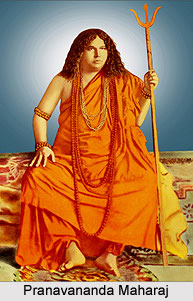 Pranavananda Maharaj, popularly also known as Yugacharya Srimat Swami Pranavananda Ji Maharaj, was the founder of the Bharat Sevashram Sangha organisation. He is primarily remembered for his groundbreaking efforts to bring the modern Hindu society into the new era without compromising the fundamental values of early traditions of Hindu spirituality. Swami Pranavananda Maharaj was one of the most prominent spiritual leaders of modern India. He is respected for his compassion for all humanity, message of universal love and social reform without compromising the nationalist passion.
Pranavananda Maharaj, popularly also known as Yugacharya Srimat Swami Pranavananda Ji Maharaj, was the founder of the Bharat Sevashram Sangha organisation. He is primarily remembered for his groundbreaking efforts to bring the modern Hindu society into the new era without compromising the fundamental values of early traditions of Hindu spirituality. Swami Pranavananda Maharaj was one of the most prominent spiritual leaders of modern India. He is respected for his compassion for all humanity, message of universal love and social reform without compromising the nationalist passion.
Early Life of Pranavananda Maharaj
Yugacharya Srimat Swami Pranavananda Ji Maharaj was born on 19 January 1896 on the day of Magha Purnima, in Bajitpur village in the district of Faridpur in undivided India (now in Bangladesh). He was born to the parents Bishnu Charan Bhuia and Saradadevi. He demonstrated unusual philosophical inclinations from his childhood. He met with Yogiraj Baba Gambhirnathji Maharaj at Gorakhpur in the year 1913. Pranavananda Maharaj was formally taught about philosophy and spirituality by Baba Gambhirnathji Maharaj.
Bharat Sevashram Sangha
Pranavananda Maharaj launched a mission to conduct social services and propagate his spiritual notions in the tradition of Sanatan Dharma Hindu religion. Thus he established the Bharat Sevashram Sangha in the year 1917 on the Maghi Purnima day in order to give a formal shape to the mission. With the activities of the Sangha establish he tirelessly efforted to awaken and unite all sections of the people in order to build strong India. Various missions were also founded abroad to broadcast the traditional Hindu message of universal love and devotion to all humanity. The Bharat Sevashram Sangha constructed several cottage industry centres, primary schools, monastic schools and free dispensaries in urban and rural regions through out East India. Later a number of branches were also founded in different regions of the nation for various humanitarian activities like relief works during floods, earthquakes, famines and epidemics. The organisation also runs many non profit clinics, guest houses and hospitals through out the country, helping any body in need, regardless of any discrimination of caste, religion and creed.
The Bharat Sevashram Sangha has responded to various natural calamities in many occasions, such as in the Indian states of Orissa and Andhra Pradesh, the famine in Bengal in the year 1943, the Bhopal gas disaster, the earthquake in Gujarat in the year 2001 and the Indian Ocean tsunami in 2004. Bharat Sevashram Sangha also established war evacuee camps and refugee camps near the border territories during the periods of political unrest like the Partition of India. The non governmental organisation also organised many projects to help impoverished and destitute tribal people in the country. The Sangha also made arrangements for providing schooling to children of the Sabar tribe. Moreover it also provided them with healthcare and housing facilities.
Activities of Pranavananda Maharaj
Pranavananda Maharaj propagated practical spirituality in preference to theoretical philosophy. The fundamental truths on his teaching were represented in the Sangha Geeta. Yugacharya Srimat Swami Pranavananda Ji Maharaj emphasized in the ideals of self discipline sacrifice, continence and truth.



















